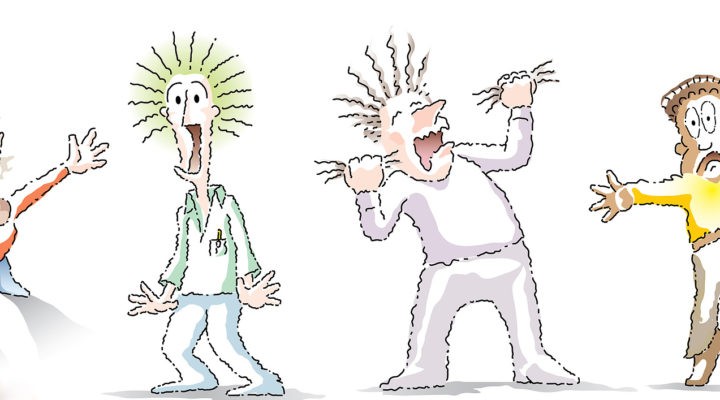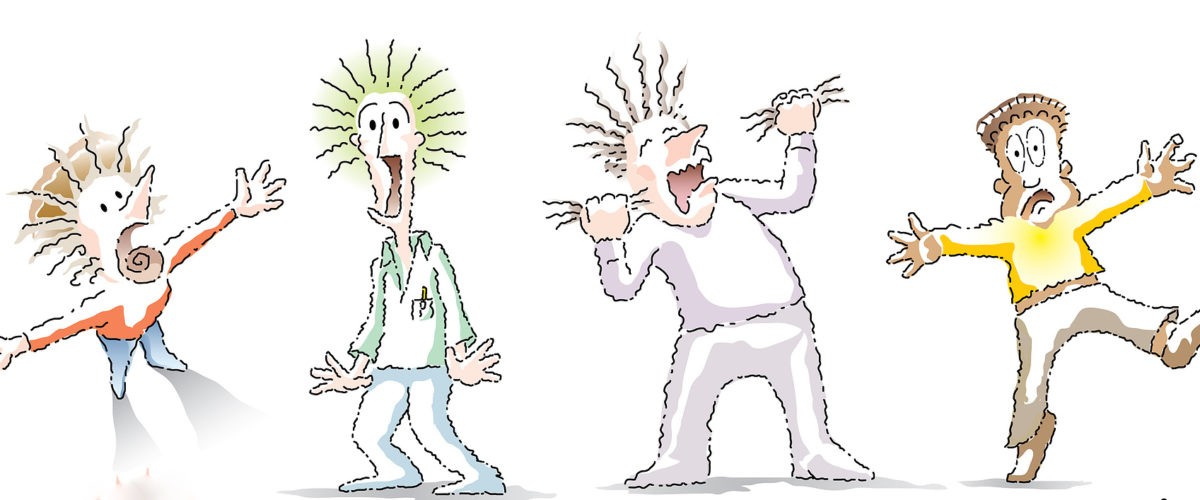I don’t know about you, but, I tell you, right now, pretty much everything is getting on my last nerve.
People who refuse to get vaccinated are getting on my last nerve. Ditto people who won’t wear masks. Republican obstructionism is getting on my last nerve. People criticizing Simone Biles are getting on my last nerve. The governors of Florida and Texas are already on my very last nerve. So is the governing body that makes women Olympic beach volleyball players wear bikinis. Democrats who can’t get their act together, billionaires who’d rather joy ride into space than pay a living wage, wildfires, voter suppression, white supremacists, conspiracy theorists, other drivers, Fox News, summer reruns, social media influencers, people in the express line with more than 15 items — it’s all getting on my last nerve.

Susan Shaw
I am a cranky, angry, feminist killjoy.
I am not alone, however. Look at the Gospels. Jesus had his share of times when he was on his last nerve. The Gospel of Mark tells us about two of these times. The first time, Jesus was walking along with his disciples, and he got hungry. Now he knew good and well it wasn’t fig season, but he saw a fig tree, and so he went to look for some fruit. Then, when the poor tree didn’t have any, because, mind you, it was not fig season, Jesus cursed the tree. I love how Mark puts it: “He said to it, ‘May no one ever eat fruit from you again.’ And his disciples heard it.” Can you imagine what they were thinking? Jesus has gone and cursed a fig tree for not having fruit when it isn’t even fig season! Don’t you think they minded their p’s and q’s for the rest of that walk?
Then, in the very next story in Mark’s Gospel, Jesus saw what was going on at the temple, and enough was enough. He started flipping over tables and chasing the moneychangers out of the temple, and he wouldn’t even allow anybody to carry anything across the temple.
We read and talked about this story in my Southern Baptist church when I was growing up. We always focused on the righteousness of Jesus’ condemnation of those in the temple, but we never talked about the fact that Jesus had himself a little moment here.
My spouse, Catherine, has this habit of unintentionally running words together when she has two words she’d like to use. Recently she came out with “tissy fit,” a mash-up of tizzy and hissy fit. But I’d say that word is just right. Jesus had himself a tissy fit! My church somehow pretended that this was perfectly normal, nothing to see here, don’t look at the Son of God turning tables over and driving people out of the temple with a whip, according to John’s Gospel.
“These were hardly the only times Jesus got snippy. Once I started looking for these stories, I found them all over the Gospels.”
But these were hardly the only times Jesus got snippy. Once I started looking for these stories, I found them all over the Gospels. One time Jesus asked his followers, “How much longer must I put up with you?” Quite a few times, he called someone who had disappointed him, “O, you of little faith.” It seems like his favorite phrase for religious leaders was “you hypocrites.” And remember when he said to Peter, “Get behind me, Satan?”
This is what he said about people who get in the way of other people’s faith: “If any of you put a stumbling block before one of these little ones who believe in me, it would be better for you if a great millstone were hung around your neck and you were thrown into the sea. If your hand causes you to stumble, cut it off; it is better for you to enter life maimed than to have two hands and to go to hell, to the unquenchable fire. And if your foot causes you to stumble, cut it off; it is better for you to enter life lame than to have two feet and to be thrown into hell. And if your eye causes you to stumble, tear it out; it is better for you to enter the kingdom of God with one eye than to have two eyes and to be thrown into hell, where their worm never dies, and the fire is never quenched.”
Wow. This is not little Jesus meek and mild. Somebody got on his last nerve!
I have to tell you, I love this Jesus. This is not the Jesus of the stained-glass window. This is the Jesus I can relate to, the Jesus who’s at times fed up with everybody and everything. This is Jesus with a temper. Impatient Jesus. Unreasonable Jesus. Face palm Jesus. This is the Jesus who tried his best at times to run away from the crowds that kept following him, who tried to take a nap in a boat only to be awakened by his disciples because of a storm.
“This Jesus of the Gospels got tired and hungry and cranky, and I love him for it.”
This Jesus of the Gospels got tired and hungry and cranky, and I love him for it — because if Jesus can feel this way and have the occasional tissy fit, so can I. I don’t have to try to generate some artificial happiness when I’m mad as hell. I don’t have to smile when I find myself face to face with some misogynist telling me I’d look so much better if I did. I don’t have to feel guilty for those normal human feelings of frustration and anger and frenzy. I don’t have to pretend I don’t see what’s right in front of my eyes or act like it’s OK for everybody just to make their own decisions about masks and vaccines and social distancing.
If we look back at the stories of the fig tree and temple, we find some interesting things. Mark uses an important literary device throughout his Gospel. My New Testament professor Jim Blevins called it the “Markan sandwich.” This happens when Mark wraps one story around another, and the outer story helps interpret the inner story.
In this instance, the fig tree is the outer story, and Jesus’ tissy fit in the temple is the inner story. The rest of the fig story goes like this: “In the morning as they passed by, they saw the fig tree withered away to its roots. Then Peter remembered and said to him, ‘Rabbi, look! The fig tree that you cursed has withered.’ Jesus answered them, ‘Have faith in God.’”
Some scholars suggest that a more accurate reading of the first part of the story, the curse, would be, “May no one eat fruit from you to the end of this age,” leaving open the possibility that the fig tree may bloom in the future. In other words, the story encourages the disciples to have faith that the fig tree will be restored.
“Even at his most tired, impatient and upset, Jesus still found a way to hold onto a vision of a better world.”
So what does that suggest about how we read the story of Jesus throwing tables around in the temple? That story draws quotations from two sources — Jeremiah and Isaiah. Jeremiah rails against foreign influences that have corrupted temple worship. The problem wasn’t that people exchanged Roman coins for temple coins or that they bought animals for sacrifice. The problem was that, under Rome, the temple had become commercialized and the priesthood had become a political job with high priests appointed by and collaborating with the Romans. So instead of being committed to the temple, they were committed to collecting taxes for the Roman Empire.
The passage from Jeremiah places Jesus in the reforming tradition of earlier prophets. The passage from Isaiah, however, also points to a vision of a future when all people are included in the covenant. Mark creates this tension to show Jesus as both a reformer and a visionary seeking to bring all people together, as he said, the temple should have been a house of prayer for all the nations.[i]
So even at his most tired, impatient and upset, Jesus still found a way to hold onto a vision of a better world.
I try to be like Jesus. When somebody or something is on my last nerve, I try to let go of whatever it is that’s driving my frustration. I try to believe in a better world. I’ll sing to myself that line from “Frozen,” “Let it go. Let it go.” Of course, then that will get stuck in my head, and it will get on my last nerve.
Being a reformer and a visionary when we’re about to go over the edge is really hard.
The Dali Lama told a story about a Tibetan monk who was long imprisoned and tortured by the Chinese. The Dali Lama asked the monk what, during his imprisonment, he most feared. The monk replied that what he most feared was losing compassion for the Chinese. I fear losing compassion. Or, as the poet Wendell Berry asks, “how will you not hate them, and so become a monster of the opposite kind?”
“When the world is getting on our last nerve, we go to compassion.”
When the world is getting on our last nerve, we go to compassion. It’s like Michelle Obama said, “When they go low, we go high.”
We may not feel like going high. We may feel like cursing fig trees and flipping over tables. It’s OK to admit that everything and everybody is getting on our last nerve. If Jesus can have those moments, so can we.
We just don’t want to get stuck there. We want to find our way to compassion, even if we have to grit our teeth while we’re getting there.
I appreciate these lines from Quaker singer-songwriter Carrie Newcomer:
When forgiveness is hard to find
Lean in toward the Light
Help me at least to be kind
Lean in toward the Light
I guess I’d say to all of us, when everything is getting on our last nerve, lean in toward the Light and at least be kind. I think in this moment that may be about the best we can do, and, at the end of the day, that’s enough.
[i] New Collegeville Bible Commentary: New Testament. Ed. Daniel Durken. Collegeville, Minn.: Liturgical Press, 2008.
Susan M. Shaw is professor of women, gender and sexuality studies at Oregon State University in Corvallis, Ore. She also is an ordained Baptist minister and holds master’s and doctoral degrees from Southern Baptist Theological Seminary. Her most recent book is Intersectional Theology: An Introductory Guide, co-authored with Grace Ji-Sun Kim.
Related articles:
What do we do now? The blessing and curse of COVID to the church | Opinion by Keli Rugenstein
A reflection on Amanda Gorman’s inaugural poem | Opinion by Richard Hester
Right now, we need angry Jesus | Opinion by Laura Mayo


